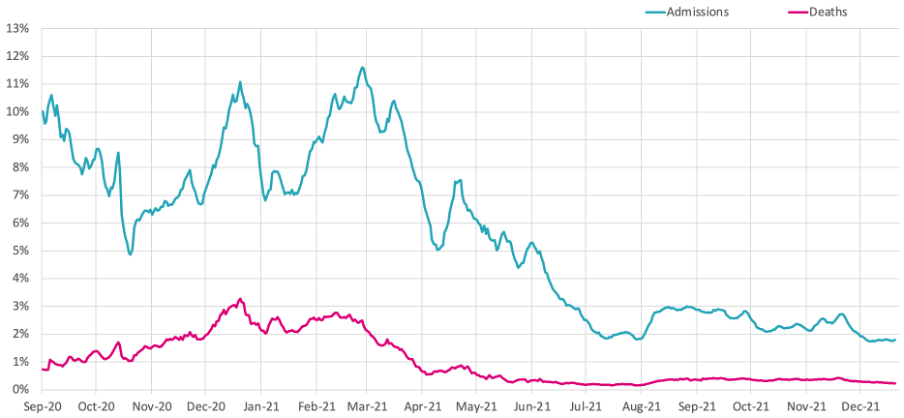CF rapid analysis: assessing the real-time impact of Omicron on the NHS over the holiday
The country—and indeed the world—is gripped by the effects of the new Omicron variant. Many had hoped that Covid would recede, but the recent mutation has increased the rate of infections and startled many countries into tighter lockdowns and travel restrictions. While the UK has held off on further lockdowns, the government continues to demonstrate how its data capture and genomic sequencing capabilities have put it at the forefront of learning in real time from volatile and ever-changing circumstances.
CF has undertaken rapid analysis of publicly available data that shows how the impact of Covid has evolved over time, with recent data signalling lower hospitalisation rates and lower death rates as a percentage of cases. This has been reported widely, but we thought it was useful to show trend data on all Covid cases in the UK over time. This is inevitably due to a combination of factors, including the proportion of people who have Covid, the level of vaccinations and the mutation of the Omicron variant. This analysis does not quantify the impact of Omicron specifically, but rather focuses on key changes in the current environment.

We have looked at this based on accessing published UK Government data as well as filtering down to look at London. What we can see is that:
- Current Covid cases have exceeded the previous peak and surged past last year’s levels, achieving 200% of January peak in the UK and in London, which has 100,000 daily infections.
- Last January saw nearly 40,000 patients in hospital and over 1,000 deaths per day. This varies significantly to the current situation, where cases are at 201% of the previous peak, hospital admissions are at 24% and deaths are at 12%.
- While the shape of the UK as a whole and London are different, general trends and patterns remain remarkably similar.
- London has seen a doubling in hospital admissions over the last two weeks, despite the small national increase. London now makes up 25% of national admissions.

The first challenge to the NHS will not be physical capacity but staff capacity, given rising staff absences from Covid or self-isolation. It would take 250,000 daily cases to reach the occupancy seen in the previous peak, and today’s 120,000 cases show we are nearly halfway there. With the current doubling rate, such a reality is possible, though it seems people are reducing social contact, with drops in all forms of mobility, which may stagnate growth.
As the BMA estimates 50,000 NHS workers may be off by Christmas, with 100,000 absences in a worst-case scenario, NHS and government leaders should closely monitor how health care services can operate given the limited staffing capacity available.
The drop in admission rate and mortality rate is welcome news. While watching the data closely, NHS leaders will be critically focused on the workforce. We will all hope for a continued moderation of the virus leading to a brighter 2022.
Sources:


